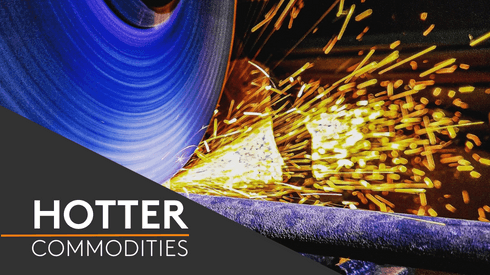JP Morgan predicts slower copper mine growth and rising prices
“China has actually driven all of the copper demand growth we’ve seen over the past 15 years,” JP Morgan head of metals and mining commodity strategy Amy Gower said.
She also noted that growth in China’s manufacturing industry had offset current weakness in the Chinese property sector, in terms of demand for copper.
JP Morgan expects China’s demand growth to come in at 2-3% a year, slightly lower than previous years, and predicts mine supply growth at 1.7% until the end of the decade, down from 2.7% in the 2010s.
The company forecasts that slower mine supply growth will force the market to rely on scrap and secondary materials.
JP Morgan predicts a deficit in copper for this year and for 2025 and expects that prices will be on an upward trajectory, with an anchor price of around $9,500 tonnes.
On the concentrates side, a lack of mine supply and high levels of investing in smelter capacity have led to the current very low treatment charges (TCs).
Fastmarkets calculated the copper concentrates TC index, cif Asia Pacific at $2.00 per tonne on Friday September 27, down from $87.70 per tonne at the same time last year.
“We have moved toward a surplus of capacity but haven’t seen the mine side catch up,” Gower said.
Participants keep a close eye on annual benchmark negotiations for copper concentrates, which are $80 per tonne for 2024.
JP Morgan expects that the 2025 TC benchmark will be “around $30 per tonne,” Gower said.
What to understand more about what’s ahead in the copper industry? As copper prices reach record highs and analysts warn of ‘unsustainable deficits’, we explore the key trends shaping the copper market. Read more here.
China and Indonesia dominate nickel supply and demand
China and Indonesia account for 75% of the market in terms on both the supply and demand side, Macquarie analyst Jim Lennon said.
Almost 60% of nickel production was from Indonesia this year, and Lennon expects that within the next five years 75% of global production will come from Indonesia.
Two thirds of nickel goes toward stainless steel production, and Macquarie predicts 5% long-term growth for stainless steel production.
Lennon predicts that while the steel industry has previously pushed demand, the battery industry will be the key driver of nickel demand in the coming year.
The Class 1 nickel market remains heavily oversupplied, while the Class 2 nickel market is moving toward a deficit, Lennon said.
Lennon predicts that nickel prices will track sideways in the coming year.
Zinc demand to see ‘modest recovery’ in 2025
In the coming year, zinc demand will be a bigger risk than supply, according to StoneX senior metals analyst Natalie Scott Gray.
Global demand for zinc has been muted this year amid a struggling construction sector in both Europe and Asia, but StoneX predicts a modest recovery in zinc demand for next year.
“Even with [China’s] stimulus and rates [cuts], we are not seeing a pick-up in demand until the second half of next year,” Scott Gray said.
On the supply side, mine production in zinc has fallen to three-year lows, Scott Gray said, after multiple large mines in key producing countries cut production in 2023, partially due to lower zinc prices and rising energy costs.
This has resulted in record low zinc TCs, with many participants concerned that tightness in the concentrates markets will spill into the refined side.
Fastmarkets’ twice-monthly assessment of the zinc spot concentrate TC, cif China was $(50)-(20) per tonne on September 27, unchanged since August 30.
StoneX predicts refined zinc production will fall by 1.3% this year but will grow by 3.3% next year. The company also predicts that higher London Metal Exchange zinc prices, expected demand growth in China due to the stimulus package and expected mine production increases will ease current supply-side issues.
StoneX expects tightness in the market to continue to support prices until the end of the year.
Lead mine production and demand to grow in 2025
Weaker mine production, muted demand, lower prices and falling TCs continue to impact the lead market, Scott Gray said.
Fastmarkets assessed the lead spot concentrate TC, high silver, cif China at $(40)-(20) per tonne in September, down from $0-30 per tonne in January.
She also noted that China flipped from a net exporter to a net importer of refined lead this year.
However, looking forward, she expects that both mine production and demand will grow within the next year.
StoneX predicts that lead mining will increase in 2025 due to the increase in copper, zinc and silver mining. The company also predicts that demand will grow by 2.2%, compared with flat growth last year, and expects that falling interest rates will improve demand for batteries.
Macro tailwinds and modest fundamentals will result in slightly higher LME prices next year, Scott Gray predicted.
Tin prices closely track copper
Tin prices closely track copper prices as both metals will benefit from the energy transition, senior market intelligence analyst at the International Tin Association (ITA) Tom Langston said.
Tin is the best performer of the base metals so far in 2024. The three-month LME tin price was $33,458 per tonne at the end of September, up by 32.9% from $25,184 per tonne at the beginning of January.
Langston noted that the global tin market continues to face supply-side challenges, with delays in deliveries from Indonesia due to licensing issues and shipments from Myanmar down by 44% since last year.
Mine supply fell by 9% amid a drop in tin concentrates.
The ITA forecasts a deficit of 10,000 tonnes in the tin market in 2024 and expects the market to remain tightly balanced in recovery growth until 2028. It also predicts that current supply challenges are manageable and should ease in 2025.
The current shortfall in production supports higher tin prices, Langston said, and he expects that to incentivize greater production levels in the coming year.
The ITA expects that demand for tin will continue to grow due to increased demand in the electric vehicle, solar and semi-conductor industries.
Inform your base metals strategy with Fastmarkets’ price forecasts and analysis for the global base metals industry. Learn more.






